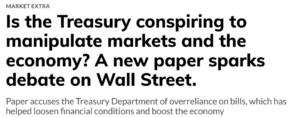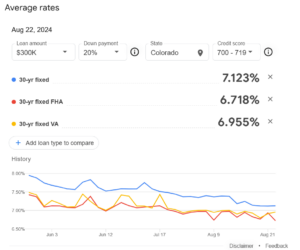
The million dollar question is where do interest rates head from here. The Federal reserve has hinted at more upcoming cuts, what does this mean for mortgage rates? Does the federal reserve actually control mortgage rates? How is the treasury department influencing longer term rates more than the federal reserve? Will mortgage rates actually head higher?
What is the market predicting on long term rates?
Lower mortgage rates in 2024 — NAR is predicting the average will be 6.3% by the fourth quarter, down from 7.8% in 2023’s final three months — will entice more owners to give up the super-low rates they got during the pandemic and put their homes on the market, Yun said. That will cause the inventory of properties for sale to climb about 30% from 2023’s all-time low, he said.
Wells Fargo economists have a rosier outlook than NAR, predicting the average 30-year fixed rate will fall to 6% by the end of 2024, close to the Mortgage Bankers Association’s forecast of 6.1%. Fannie Mae, the largest mortgage financier, has the least optimistic outlook of the major forecasters, predicting the average will be 6.5% by the end of the year.
There are three drivers of long-term rates
Mortgage rates are not set by the federal reserve, they are driven by the market and future expectations. Below are the three main drivers of interest rates. Ironically the largest influence recently of long term interest rates is actually the Treasury department and not the Federal Reserve.
- Inflation Expectations: One of the major drivers Treasury pricing is driven by future expectations on inflation. Is the economy going to grow and are prices going to rise? Currently inflation expectations are heading in the right direction which is giving some reprieve to interest rates. But, at the same time other market forces (supply and demand of treasuries) seem to be working in the opposite direction. Furthermore, the recent inflation readings have shown rising prices once again basically reversing the progress made earlier in the year. The wildcard is that inflation seems to be “stickier” than anticipated so the federal reserve will not be cutting rates as soon or as much as the market had anticipated.
- Market Forces: This refers to basic supply and demand. Demand is driven by investors in the US along with many investors and countries abroad that park their money in US treasuries due to the safety and liquidity. The large demand for treasuries has increased prices and therefore kept yields (rates) at historic lows. On the flip side is supply. The more supply of treasuries, the lower the price and the higher the yield (remember they move in opposite directions). The borrowing needs of the US will continue to grow with deficit spending. The non-partisan congressional office (CBO) has confirmed this as well with deficits predicted to swell in the coming years
-
- Supply: The supply of treasuries will continue growing rapidly as the government continues deficit spending. Unfortunately both major parties seem to be content with deficit spending as there has both parties will ensure deficits well into the future. The bigger budget shortfalls will add to the more than $10 trillion-plus rise in federal debt over the next decade that the Congressional Budget Office is already forecasting.” Treasury issuance will continue to rise as the budget shortfall increases. In a nutshell, supply will continue to increase which will drive prices down and yields up. We are seeing this in the recent 30 year treasury auction
- Demand: At the same time supply is starting to rise, the demand for treasuries is starting to wane. As the soft landing narrative takes hold there has been less of a flight to “safety” assets like treasuries. If we do avoid a recession, then demand for treasuries should remain about flat or decrease while supply will continue increasing.
- Sales of Treasuries/Bonds: The US government has been selling considerably more short dated bonds as the interest is cheaper than longer dated bonds. Unfortunately with the huge deficit spending, the market will choke on all the short dated bonds and longer dated bonds will be sold which in turn will push up longer term rates like mortgages. There are accusations that the treasury is intentionally altering their strategy to give the economy a further boost. A hedge fund study that said the U.S. Treasury last year effectively provided economic stimulus by moderating long-dated bond sales has sparked a debate in the bond market and a denial from the U.S. Treasury that said it was not aiming for such an effect.
I think the market is drastically underpricing the risk from the huge deficit spending an possible market manipulation by the treasury. Eventually the supply of bonds will capitulate the market into higher long term bond yields and in turn higher mortgage rates for the foreseeable future.
What is causing the drastic swings in mortgage rates?
It has been tough to keep track of the huge swings we are seeing in the mortgage market. There are two primary drivers of the large price swings supply/demand pulls and mortgage demand.
- Supply/Demand pulls: 10-year treasury buyers are trying to figure out if demand or supply will end the tug of war. Recently treasuries were overrun with worries about supply which drove up the yields demanded. Currently supply is the question on everyone’s mind as deficits continue. Look for the supply to continue to ramp up over the year which will overtake demand on the longer dated maturities.
- Risk Premium: From the chart above on 30year treasuries, the market is worried about where long term rates go from here. The chief concern is supply of treasuries due to a huge deficit that shows o signs of easing. As supply increases ultimately prices will be pushed down and yields will increase. Mortgage buyers therefore are putting in a risk premium for the longer dated securities as there is a fear that over the long term rates will settle substantially higher.
- Sales of shorter dated bonds: The treasury department is undoubtedly influencing long term rates by selling more shorter dated bonds. If the treasury sold a more balanced amount of longer and shorter dated securities interest rates would likely be ½% to 1% higher than they are today. The million dollar question is if the Treasury can continue this strategy or does the market at some point force it to sell more longer dated bonds due to lack of demand.
Predicted Fed cuts unlikely to materially change real estate in 2024
Federal Reserve Chairman Powell has stated that now is the time to start changing their tune and focus on employment as opposed to inflation. September is the first rate cut and subsequent cuts will be decided based on the data. The million-dollar question is how many cuts and by what amount. If I assume the market has not factored in more substantial cuts, this will lead to mortgage rates in the 6.5%-7% range for the remainder of 2024.
Furthermore I think that the market is already pricing in the future cuts predicted for 2024. The wildcard is what happens with the Treasury department. If the treasury department begins selling more longer dated securities, which the market my force due to the huge debt issuances, then longer term rates could head higher than they are today or at a minimum not drop much more.

What should you do to get the best rates in 2024?
With rates moving rapidly from day to day, what should you do? First, full disclosure, I’m not giving financial advice so talk with your bank or mortgage broker if you have questions. Based on the market there could be some opportunities for lower rates:
- Look at a variable rate product: I don’t foresee rates going much higher than they are today so it might be wise to look at an adjustable rate product to get a lower rate and buy you time for rates to fall further. I would look at 3/1 or 5/1 options as this should provide ample time to see where the market heads. Unfortunately as of this writing some of the shorter term maturities were trending higher than the fixed rate options so you will need to be careful if it is even worth the risk to go into a shorter term product.
- Be flexible on when you lock in your rate: I would be hesitant to lock in a rate too early as the market is moving quickly. You need to be flexible when you lock to take advantage of big dips in rates. There should be some opportunities in 2024 as the data is all over the place and can move the markets quickly. As we saw after the June CPI numbers were announced there was a quick drop in long term treasuries which over the next several days reversed.
Summary of mortgage rate predictions:
The biggest positive about interest rates is that for now the highest mortgage rates should be behind us. On the flip side, don’t buy the hype that mortgage rates are going to rapidly fall as deficit spending continues to grow and at some point the treasury department will have to face the music and issue more longer dated securities.
Look for rates to move maybe half a point in 2024 and this move could be in either direction meaning rates could increase half a percentage or fall a half a percentage depending on upcoming inflation data. Unfortunately, with the huge deficit spending by both parties, rates likely will remain in this range for a while which will continue to impact affordability and in turn the real estate market.
With rates not coming off much, look for 2024 to continue with lower volumes and prices holding steady or possibly coming off a little bit. I don’t foresee a huge price reset the last 6 months of the year as the economy stays in a holding pattern and the federal reserve is determined not to make waves during an election year. Definitely not bad news, but also not a roaring come back as the national association of realtors is predicting.
Fortunately I don’t foresee anything major happening the remainder of 2024 as the federal reserve will work hard to stay out of the spotlight in an election year. This means we will have to wait and see in 2025 but it definitely looks like something big could happen next year.
The real question is what happens in 2025. Currently the federal reserve is assuming 3 or 4 cuts which should equate to a bit lower mortgage rates possibly closer to 6-6.5% but this is all predicated on a soft landing and no cracks in the economy. The million dollar question is when or if will we see a reset in prices and the general economy?
Additional Reading/Resources:
- https://www.reuters.com/markets/us/hedge-fund-study-us-treasury-issuance-fuels-debate-2024-07-26/
- https://www.marketwatch.com/story/is-the-treasury-conspiring-to-manipulate-markets-and-the-economy-a-new-paper-sparks-debate-on-wall-street-0883625c
We are a Private/ Hard Money Lender funding in cash!
If you were forwarded this message, please subscribe to our newsletter
Glen Weinberg personally writes these weekly real estate blogs based on his real estate experience as a lender and property owner. I’m not an armchair reporter/writer. We are an actual private lender, lending our own money. We service our own loans and own commercial and residential real estate throughout the country.
My day job is and continues to be private real estate lending/ hard money lending which enables me to have a unique perspective on the market. I don’t accept any paid sponsorships or ads on my blog to ensure accurate information. I’ve been writing this for almost 20 years and have over 30k subscribers. Please like and share my blogs on linkedin, twitter, facebook, and other social media and forward to your friends . I would greatly appreciate it.
Fairview is a hard money lender specializing in private money loans / non-bank real estate loans in Georgia, Colorado, and Florida. We are recognized in the industry as the leader in hard money lending/ Private Lending with no upfront fees or any other games. We fund our own loans and provide honest answers quickly. Learn more about Hard Money Lending through our free Hard Money Guide. To get started on a loan all we need is our simple one page application (no upfront fees or other games).
Written by Glen Weinberg, COO/ VP Fairview Commercial Lending. Glen has been published as an expert in hard money lending, real estate valuation, financing, and various other real estate topics in Bloomberg, Businessweek ,the Colorado Real Estate Journal, National Association of Realtors Magazine, The Real Deal real estate news, the CO Biz Magazine, The Denver Post, The Scotsman mortgage broker guide, Mortgage Professional America and various other national publications.
Tags: Hard Money Lender, Private lender, Denver hard money, Georgia hard money, Colorado hard money, Atlanta hard money, Florida hard money, Colorado private lender, Georgia private lender, Private real estate loans, Hard money loans, Private real estate mortgage, Hard money mortgage lender, residential hard money loans, commercial hard money loans, private mortgage lender, private real estate lender
